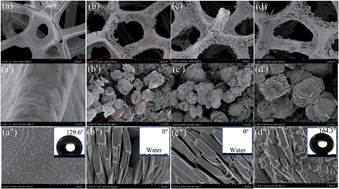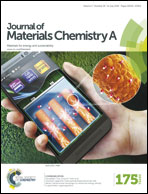A robust bilayer nanofilm fabricated on copper foam for oil–water separation with improved performances†
Abstract
In this work, a facile approach of covalent layer-by-layer assembly was applied to fabricate a bilayer nanofilm which renders roughened copper foam superhydrophobic with robust performances. Before constructing the bilayer nanofilm, the surface of the foam was roughened by using KOH–K2S2O8 as the oxidation system, giving rise to hierarchical structures of flower-like protrusions and petals. A multifunctional polymeric nanofilm, capable of resisting copper corrosion and serving as an activated interface simultaneously, was first introduced onto the copper surface by heating self-assembled monolayers (SAMs) of one triazinedithiolsilane compound (designated as TESPA). Then, perfluorodecyltrichlorosilane (abbreviated as PFDTCS) was anchored onto the TESPA-modified copper surface. Consequently, a bilayer nanofilm of PFDTCS–TESPA is generated on the hierarchical foam that possesses outstanding superhydrophobic capability. The as-prepared foam exhibits excellent reusability and separation efficiency. After fifty recycles, the separation efficiency exceeds 98% while the surface still retains remarkable superhydrophobicity. The improved efficiency and recycle number are outstanding compared to those of similar systems reported previously. X-ray photoelectron spectroscopy (XPS) was conducted to reveal the mechanism of the robust performances of the bilayer-coated foam. The results show that TESPA can react with copper oxide (CuO) through SH groups yielding TESPA SAM. Upon heating, the newly formed disulfide units (–SS–) and siloxane networks (SiOSi) of the TESPA polymeric nanofilm protect the copper; the outward silanol groups (SiOH) endow the surface with activating ability. PFDTCS can covalently bond to the TESPA polymeric nanofilm via these SiOH groups. The specific arrangement of PFDTCS–TESPA and the chemical bonds of Cu(I)S, as well as the three-dimensional (3D) cross-linked textures of –SS– units and SiOSi networks, cooperatively enhance the chemical durability of the bilayer. The design strategy of preparing the bilayer nanofilm via an interlayer (e.g., TESPA as a molecular adhesive displayed in this work) can also be applied in other superhydrophobic systems for improved long-term utilization.


 Please wait while we load your content...
Please wait while we load your content...